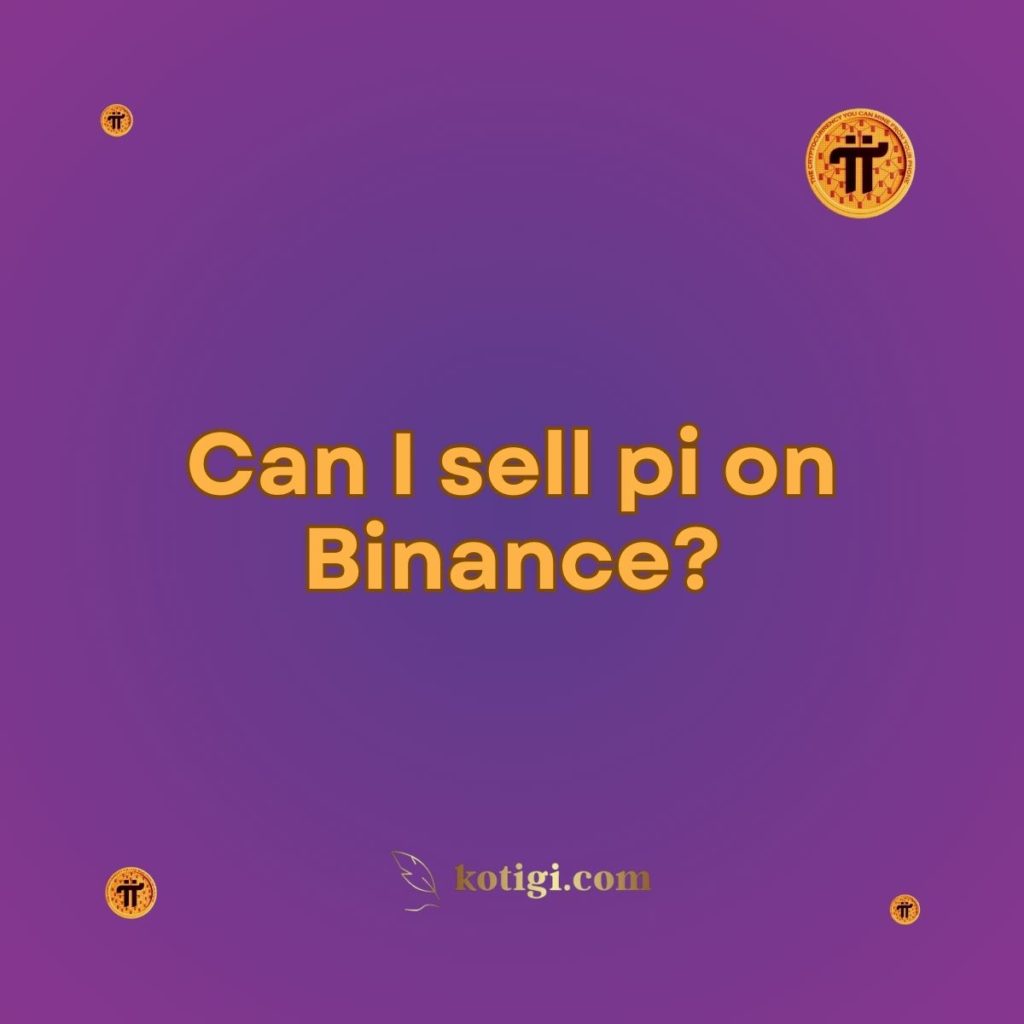
Can I sell pi on Binance?
As of now, Pi Network is not listed on Binance or any other major cryptocurrency exchanges. This is because Pi is still in its Testnet phase, and the Mainnet has not yet been launched. Once Pi reaches the Mainnet stage and gets listed on exchanges like Binance, selling Pi will become possible. Read on to explore the current status of Pi and its future potential for being traded on Binance.
Introduction
The rise of Pi Network has generated a lot of excitement within the cryptocurrency world. With its mobile mining capabilities and growing user base, many people are wondering if they can sell Pi on major cryptocurrency exchanges like Binance. While Pi has made significant progress since its launch, there are some critical factors to consider regarding its status and potential for being listed on Binance. In this post, we’ll answer the question, “Can I sell Pi on Binance?” and discuss Pi’s development, its future listing potential, and what steps are necessary before you can trade Pi on Binance or similar exchanges.
Current Status of Pi Network
What Is Pi Network?
Pi Network is a decentralized cryptocurrency that can be mined using mobile devices. Unlike traditional cryptocurrencies like Bitcoin and Ethereum, which require powerful mining hardware, Pi allows users to mine coins using their smartphones with minimal energy consumption. This has made Pi accessible to a broader audience, especially those who may not have the resources to participate in traditional crypto mining.
The goal of Pi Network is to create a user-friendly cryptocurrency that can be mined by anyone, and it has quickly grown in popularity. Millions of users, known as “Pioneers,” are currently mining Pi through the Pi Network app, contributing to the growing ecosystem.
Pi’s Development Phases: Testnet and Mainnet
To understand when Pi might be available for sale on Binance or other exchanges, it’s essential to know where Pi Network stands in its development roadmap. The network is divided into multiple phases:
- Phase 1: Design and Distribution
During the early stages, Pi Network focused on building its user base and refining the mining mechanism. This phase was aimed at growing the network and distributing Pi to users. - Phase 2: Testnet
Pi is currently in the Testnet phase, where the network is being tested for security, scalability, and functionality. The Testnet allows users to mine Pi and make transactions within the network, but these Pi coins do not yet have any market value, and they cannot be sold or traded on external platforms like Binance. - Phase 3: Mainnet
The Mainnet launch will be the defining moment for Pi. Once Pi transitions to its Mainnet, the network will become fully operational, and Pi coins will gain real-world value. This is when Pi could potentially be listed on exchanges like Binance, allowing users to sell or trade their Pi.
Why Pi Is Not Yet Tradable?
Pi Network is still in its Testnet phase, which means that it is not yet available on any cryptocurrency exchanges. Coins mined during this phase are placeholders and are not yet considered tradable assets. The development team is focused on ensuring the network is secure and stable before opening it up to the broader cryptocurrency market. Only once the Mainnet launches will Pi be tradable, and exchanges will be able to list it for buying, selling, or trading.
What Is Binance?
Overview of Binance
Binance is one of the world’s largest cryptocurrency exchanges, providing users with a platform to buy, sell, trade, and store a wide range of cryptocurrencies. Launched in 2017, Binance has quickly become a go-to platform for both experienced and new cryptocurrency traders, offering low fees, advanced trading features, and access to hundreds of cryptocurrencies.
Why Binance Is a Popular Exchange?
Binance’s popularity stems from its extensive list of supported cryptocurrencies, easy-to-use interface, and advanced trading tools. It also offers a range of features beyond just buying and selling, such as staking, futures trading, and liquidity pools. Binance supports several major cryptocurrencies, including Bitcoin (BTC), Ethereum (ETH), and Litecoin (LTC), as well as many altcoins. The platform’s liquidity, security, and features make it a top choice for users who want to trade digital assets.
How Does Binance Decide Which Cryptos to List?
Binance is known for its strict listing criteria. Cryptocurrencies that want to be listed on Binance must meet certain requirements related to the project’s development, security, utility, and community support. Binance tends to list coins that have demonstrated real-world use cases, a strong development team, and a clear roadmap.
The exchange also considers the following factors when deciding whether to list a cryptocurrency:
- Project viability and innovation
- Security and decentralization
- Community engagement and growth
- Clear roadmap and milestones
- Regulatory compliance
For Pi to be listed on Binance, it would need to meet these criteria and pass Binance’s due diligence process.
What Needs to Happen Before Pi Can Be Sold on Binance?
Launch of Pi’s Mainnet
The most crucial step for Pi to be listed on Binance is the successful launch of its Mainnet. Without the Mainnet, Pi cannot be traded or listed on any exchanges because it doesn’t yet have a tangible value. The Mainnet launch will give Pi coins real-world value, making it possible to trade them for other cryptocurrencies or fiat currencies.
Pi’s development team has outlined several goals for the Mainnet, including:
- Building a secure and scalable network.
- Completing KYC (Know Your Customer) verification for users.
- Creating decentralized apps (dApps) within the Pi ecosystem.
- Expanding the use of Pi in peer-to-peer transactions and marketplaces.
Once these milestones are met, Pi will be ready for its Mainnet launch, and the potential for listing on Binance and other exchanges will increase significantly.
KYC Verification for Users
One of the key steps that Pi Network is implementing before the Mainnet launch is KYC verification. This process ensures that users are legitimate and helps prevent fraud and illegal activities within the network. KYC compliance is critical for any cryptocurrency that wants to be listed on reputable exchanges like Binance. Pi users must complete the KYC process before they can trade or sell their Pi coins on any exchange.
Community and Ecosystem Growth
For Pi to be considered for listing on Binance, it needs to demonstrate that it has a vibrant and engaged community. Binance values projects that have strong user bases and active development teams. Pi has already built a large global user base, with millions of active miners. The next step is to show that this community is actively using Pi in real-world applications, such as peer-to-peer transactions and decentralized apps (dApps).
Pi’s development team is also working to expand the Pi ecosystem by encouraging developers to build dApps on the Pi blockchain. The more Pi can demonstrate its utility and adoption, the higher the likelihood that it will be listed on major exchanges like Binance.
What Happens After Pi Is Listed on Binance?
Trading Pi on Binance
Once Pi is listed on Binance, users will be able to trade their Pi coins just like any other cryptocurrency. This means that Pi holders can sell their Pi in exchange for fiat currencies like USD, EUR, or other cryptocurrencies like Bitcoin or Ethereum. Binance provides several trading pairs for each listed coin, allowing users to choose how they want to trade their assets.
Binance also offers different types of trading, including spot trading (buying/selling Pi at current market prices) and futures trading (speculating on the future price of Pi). Advanced traders can take advantage of these options to maximize their trading strategies.
Liquidity and Price Volatility
After Pi is listed on Binance, its price will be determined by supply and demand in the market. Like all cryptocurrencies, Pi’s price will be subject to market volatility. Pi’s price could rise or fall based on factors such as market sentiment, investor demand, and broader cryptocurrency trends.
Binance’s large user base provides ample liquidity, which means that there will likely be plenty of buyers and sellers for Pi once it’s listed. However, users should be prepared for potential price fluctuations and the inherent risks of trading cryptocurrencies.
Storing Pi on Binance
Once Pi is listed, users can choose to store their Pi coins on Binance using the platform’s secure wallet options. Binance offers a hot wallet for easy access to funds and a cold wallet for secure, long-term storage. Users can also transfer their Pi to external wallets if they prefer to manage their own security.
Risks and Challenges of Selling Pi on Binance
Market Volatility
Cryptocurrency markets are known for their volatility, and Pi will likely experience price fluctuations once it’s listed. While Pi’s value could rise due to high demand, there’s also a risk that its price could drop, especially if early adopters rush to sell their coins. Users should be cautious and prepared for market swings.
Regulatory Risks
Cryptocurrencies are subject to regulations that vary by country. Depending on where you live, you may face restrictions or taxes on cryptocurrency trading, including selling Pi on Binance. Users should research local regulations to ensure compliance when trading Pi or any other cryptocurrency.
Competition from Other Cryptocurrencies
Once Pi is listed on Binance, it will face competition from other cryptocurrencies. The success of Pi as a traded asset will depend on its adoption, use cases, and value proposition compared to other digital currencies. If Pi fails to gain traction in the market, its price and demand could be negatively affected.
Conclusion
So, can you sell Pi on Binance? Not yet. Currently, Pi is in its Testnet phase and is not listed on any major cryptocurrency exchanges, including Binance. However, once Pi transitions to the Mainnet and gains real-world value, it is likely that Pi will be listed on exchanges like Binance, allowing users to sell and trade Pi coins.
To prepare for this future, Pi users should stay updated on the network’s development, complete their KYC verification, and participate in the growing Pi ecosystem. When Pi is finally listed on Binance, it will open up new opportunities for trading, investing, and participating in the broader cryptocurrency market.
Key Takeaways:
- Pi is not yet tradable on Binance because it is still in the Testnet phase.
- Pi’s Mainnet launch will be the critical moment when Pi could be listed on exchanges like Binance.
- KYC verification is required for users who wish to sell Pi in the future.
- Binance listing criteria include project viability, security, community engagement, and regulatory compliance.
- Users should be aware of market volatility and potential risks when Pi becomes tradable.





